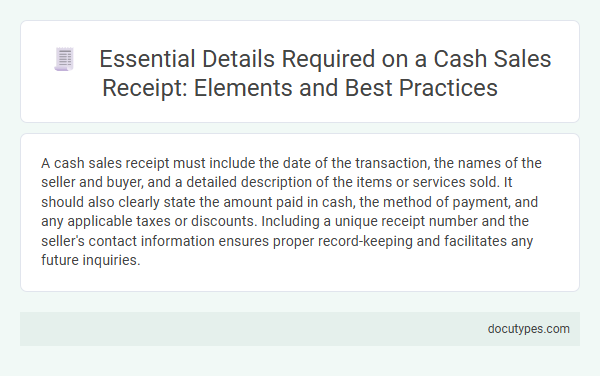A cash sales receipt must include the date of the transaction, the names of the seller and buyer, and a detailed description of the items or services sold. It should also clearly state the amount paid in cash, the method of payment, and any applicable taxes or discounts. Including a unique receipt number and the seller's contact information ensures proper record-keeping and facilitates any future inquiries.
Introduction to Cash Sales Receipts
A cash sales receipt serves as proof of payment for goods or services purchased with cash. Your receipt ensures transparency and accurate record-keeping for both the buyer and seller.
- Date of Transaction - The exact date when the cash sale occurred must be clearly stated on the receipt.
- Itemized List of Goods or Services - Detailed descriptions and quantities of purchased items must be included for clarity.
- Total Amount Paid - The receipt must show the full amount of cash received, including any applicable taxes or discounts.
Importance of Accurate Receipt Documentation
Accurate documentation on a cash sales receipt is essential for record-keeping and resolving potential disputes. It ensures transparency and protects both the buyer and seller in any transaction.
- Date of Transaction - Clearly records the exact date the sale occurred, which is crucial for tracking purchases and returns.
- Itemized List of Goods or Services - Details each product or service sold, including quantities and prices, to provide clarity and accountability.
- Total Amount Paid - Shows the final sum paid in cash, confirming the transaction value and assisting with financial records.
Mandatory Elements in a Cash Sales Receipt
A cash sales receipt must include specific mandatory elements to ensure proper documentation and legal compliance. Essential details provide clear proof of the transaction between the buyer and seller.
The date of the transaction and a unique receipt number are critical for record-keeping. Your receipt should also list the seller's name, address, and contact information for verification purposes.
Business Information: Name, Address, and Contact
What details must be present about business information on a cash sales receipt? Your receipt should clearly display the business name to identify the seller. Including the complete address and contact information helps verify and communicate with the business if needed.
Date and Time of Transaction
The date and time of the transaction are crucial details that must be present on a cash sales receipt. They serve as a precise record of when the purchase occurred, which is essential for tracking sales and resolving any disputes. Including the exact date and time helps you verify the authenticity and timing of your transaction.
Detailed Description of Goods or Services Sold
A cash sales receipt must include a detailed description of the goods or services sold to ensure clarity and transparency. This helps both the buyer and seller keep accurate records of the transaction.
Your receipt should specify the exact items or services provided, including quantities, unit prices, and any relevant specifications or features. This information is essential for tracking purchases and resolving potential disputes.
Payment Amount and Currency
The payment amount on a cash sales receipt must be clearly stated to ensure transparency between the buyer and seller. This figure represents the exact sum of money exchanged during the transaction.
The currency in which the payment is made should be explicitly indicated to avoid any confusion, especially in regions with multiple accepted currencies. Including the currency symbol or abbreviation next to the payment amount helps in maintaining accurate financial records. Proper documentation of payment amount and currency is essential for both accounting and auditing purposes.
Tax Details and Deductions
A cash sales receipt must include specific tax details such as the applicable sales tax rate and the total tax amount charged on the transaction. It should clearly itemize any deductions, including discounts or returns, to ensure accurate record-keeping and compliance with tax regulations. Providing these details helps both the seller and buyer verify the legitimacy of the sale and fulfill tax reporting requirements.
Customer Information and Signature
A cash sales receipt must include specific details to ensure clarity and legal compliance. Customer information and signature are crucial components for transaction verification.
- Customer Name - The full name of the purchaser must be recorded to identify the buyer clearly.
- Contact Information - Including phone number or email helps in follow-up communication or dispute resolution.
- Customer Signature - This serves as proof of agreement and acceptance of the sale terms.
Ensuring these details are present on a cash sales receipt protects both the seller and the customer in any future reference or legal matters.
What Details Must Be Present on a Cash Sales Receipt? Infographic

